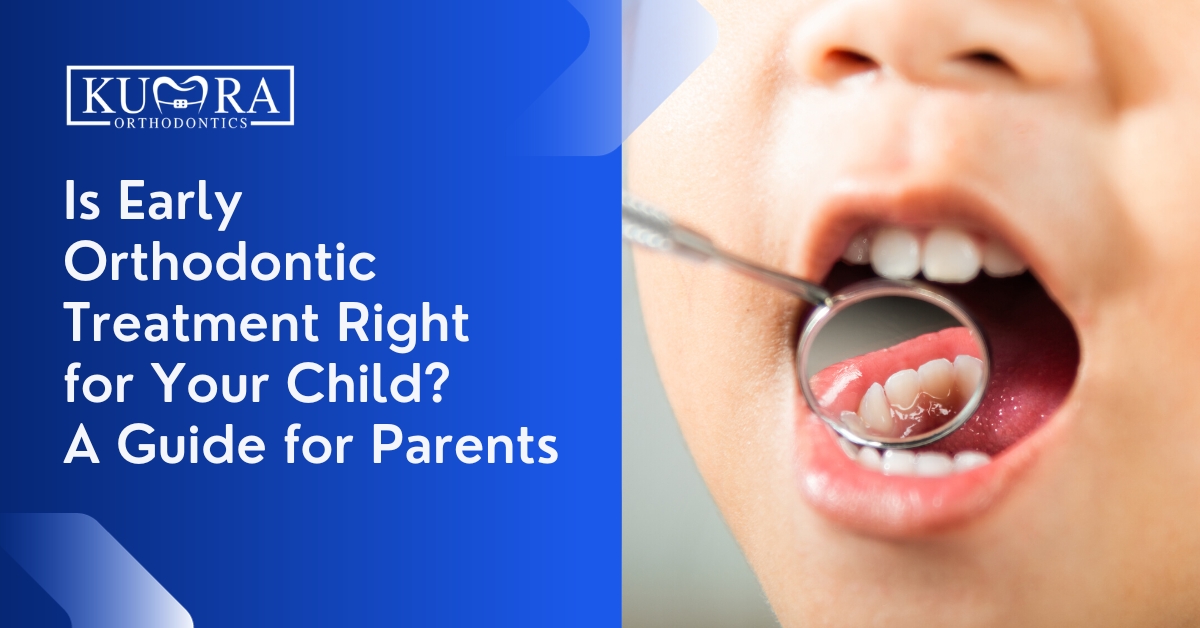A significant study has shed light on the pivotal age for orthodontic intervention, revealing that about two-thirds of orthodontic cases fall within the 11-13 age group. This finding emphasizes the critical importance of early orthodontic treatment, ideally recommended for children between the ages of 6 and 10. Engaging in such timely intervention not only addresses dental issues at an early stage but also prevents the development of more complex problems that could be challenging to correct in later years. This insight into the optimal timing for orthodontic care is a key factor in ensuring long-term dental health for children.
In this comprehensive guide, we delve into the nuances of early orthodontic treatment, helping you understand when and why it might be necessary. From identifying the signs that your child may need early intervention to exploring the benefits and considerations of such treatments, this article aims to provide you with the knowledge and confidence to make informed decisions about your child’s orthodontic care.
What is Early Orthodontic Treatment?
Early orthodontic treatment, also known as Phase 1 orthodontics, is a proactive approach to dental care, typically initiated when a child is between 6 and 10 years old. The phase of treatment is not about fitting braces for long-term use but rather focuses on intercepting and managing potential orthodontic issues before they evolve into more significant problems.
The aim here is to guide the growth of the jaw and correct problems related to the development of the teeth and jawbone. It can include expanding the palate to accommodate emerging teeth, correcting thumb-sucking habits, and addressing issues like crossbites or excessively spaced teeth.
Early treatment can significantly simplify or eliminate the need for more extensive orthodontic procedures later in your child’s life. By addressing these issues early, you’re not just straightening teeth; you’re laying the foundation for a healthy, beautiful smile that can last a lifetime.
Needing an orthodontic appointment?
Visit Kumra Orthodontics Washington, DC or Kumra Orthodontics Stafford, VA, and request an appointment with us!
Purpose of Interceptive Orthodontic Treatment
Interceptive orthodontic treatment plays a critical role in a child’s dental development. Its primary purpose is to prevent or minimize the development of more severe orthodontic problems.
The proactive approach can lead to shorter and less complex second-phase adolescent treatments, often resulting in better long-term outcomes. Interceptive treatment can manage or correct various issues, such as guiding the growth of jawbones to ensure adequate space for emerging teeth, reducing the risk of trauma to protruding front teeth, and correcting harmful oral habits.
By intervening early, it’s possible to help permanent teeth come in straighter and reduce the likelihood of needing tooth extractions. For you, as a parent, it means giving your child the best start towards a healthy, confident smile.
Is Phase 1 Orthodontics Really Necessary?
The necessity of Phase 1 orthodontics can vary greatly from one child to another. It’s crucial to remember that not all children need early treatment; however, it can be highly beneficial for those who do.
Phase 1 orthodontics is typically recommended when there is a clear indication that early intervention will prevent more serious issues from developing or make future treatments less invasive and more effective.
Common conditions requiring early intervention include severe crossbite, underbite, overbite, or overcrowding. If your child exhibits any of these conditions, early treatment can be a proactive step toward ensuring better dental health.
Regular check-ups with an orthodontist can help identify these issues early on and help decide the best course of action. It’s all about making informed decisions to benefit your child in the long run.
Best Age for Early Orthodontic Treatment
The ideal age for early orthodontic treatment is between 6 and 10. It is a crucial period in a child’s dental development, as it is when the first permanent molars and incisors usually come in. Orthodontists can capitalize on this growth phase to correct bite problems and allow permanent teeth to emerge properly.
However, it’s important to note that the appropriate age for treatment can vary. Some children might benefit from starting as early as age 6, while others might be better off waiting until they’re older.
The key is regular dental check-ups; these allow your orthodontist to monitor your child’s development and intervene at the optimal time. Early treatment doesn’t mean your child will avoid braces later, but it can make future orthodontic work simpler and less time-consuming.
Conditions that May Require Early Orthodontics
When considering early orthodontic treatment for your child, it’s important to understand the specific conditions that may necessitate this approach. Early intervention can be crucial in correcting dental issues that, if left untreated, could develop into more serious problems.
Overcrowding
Overcrowding occurs when there isn’t enough space in your child’s mouth to accommodate all their emerging teeth. This condition can lead to crooked teeth and difficulty in maintaining oral hygiene.
Early orthodontics can address overcrowding by guiding the proper alignment of teeth as they come in, potentially avoiding more extensive treatment later.
Crossbite
A crossbite is when some upper teeth sit inside the lower teeth when the mouth is closed. The misalignment can cause uneven wear on teeth and lead to more complex dental issues.
Early treatment can correct a crossbite, helping your child avoid problems with chewing and speech and preventing asymmetric jaw growth.
Overbite and Underbite
An overbite is when the upper teeth protrude significantly over the lower teeth, while an underbite is the opposite. Both these conditions can affect your child’s ability to eat and speak correctly and may lead to jaw pain and other issues.
Early intervention can help realign the bite, providing a more balanced jaw development.
Thumb Sucking and Other Oral Habits
Persistent thumb sucking or similar oral habits beyond the age of 4 or 5 can lead to issues like open bites or misaligned teeth. Addressing these habits early through orthodontic measures can prevent long-term dental problems and encourage healthier oral habits.
Pros and Cons of Early Orthodontic Intervention
Embarking on early orthodontic treatment for your child is a significant decision, and weighing the pros and cons can help you make an informed choice. Here are some benefits and downsides:
Pros
Effective Problem-Solving
Early intervention can correct orthodontic problems more effectively than waiting until your child is older. It utilizes the natural growth processes of your child’s developing mouth and jaw.
Easier Future Treatments
Addressing orthodontic issues early can simplify or even eliminate the need for more extensive orthodontic work later in your child’s life, making any future treatments shorter and less complex.
Improved Oral Health
Early treatment can help prevent problems with oral hygiene by aligning teeth properly. It makes them easier to clean and less prone to cavities and gum diseases.
Enhanced Self-Esteem
Correcting dental issues early can have a positive impact on your child’s self-esteem. A confident smile can influence their social interactions and overall happiness.
Prevents Worsening of Problems
Early orthodontics can prevent existing problems from worsening. Moreover, it can reduce the need for more invasive dental procedures in the future.
Cons
Potential for Re-treatment
Some children who undergo early treatment may still need additional orthodontic work as they grow older. It potentially leads to a longer overall treatment period.
Cost
Early orthodontic intervention can be an additional expense. This is especially true if further treatment is needed later.
Compliance Issues
Younger children may have difficulty in complying with orthodontic treatment. It includes wearing appliances correctly and maintaining oral hygiene.
Uncertainty in Outcome
In some cases, predicting the final outcome of early orthodontic treatment is challenging. The reason is because as jaw growth and the emergence of permanent teeth can vary.
Possible Discomfort
Like any orthodontic treatment, early intervention may cause discomfort for your child. It includes soreness when adjustments are made.
Expected Duration of Early Orthodontic Treatment
Embarking on early orthodontic treatment for your child is a journey towards a healthier smile, and understanding the timeline is crucial. The duration of early orthodontic treatment, also known as Phase 1 treatment, can vary significantly depending on the individual needs of your child.
Typically, this phase lasts between 6 to 18 months. However, it’s important to remember that every child’s dental development is unique, and so is the treatment duration.
Factors Influencing Treatment Duration
Several factors can influence how long your child will need to be in early orthodontic treatment. These include the severity of the dental issues being corrected, the growth rate of your child’s jaw and teeth, and how well your child complies with the treatment plan.
For example, consistent wearing of orthodontic appliances like expanders or braces can significantly affect the treatment’s effectiveness and duration.
Regular Check-ups and Adjustments
Throughout the treatment, regular check-ups with your orthodontist are essential. These appointments are crucial for monitoring progress and making necessary adjustments to the orthodontic appliances.
Regular visits not only ensure that the treatment is progressing as planned but also allow for any modifications in response to your child’s growth and development.
What To Expect After Your Child’s Interceptive Orthodontic Treatment
Post-Treatment Phase
Once your child completes their early orthodontic treatment, it’s natural to wonder what comes next. Typically, after Phase 1 treatment, there is a resting period.
During this time, the remaining permanent teeth are allowed to erupt naturally. The phase is critical as it sets the stage for the next phase of treatment, if necessary.
Monitoring Dental Development
During the post-treatment phase, your orthodontist will continue to monitor your child’s dental development. Regular visits will be scheduled to monitor the emergence of permanent teeth and ensure that the benefits gained from the early treatment are maintained.
Possible Phase 2 Treatment
Depending on your child’s orthodontic needs, a Phase 2 treatment may be recommended. The phase usually involves full upper and lower braces and begins once most permanent teeth erupt. The goal of Phase 2 is to ensure perfect alignment of all the teeth and correct bite issues, leading to a functional and aesthetically pleasing smile.
Continued Oral Hygiene
After the interceptive treatment, it’s important to continue with good oral hygiene practices. Regular brushing and flossing, along with routine dental check-ups, will help maintain the treatment results and the overall health of your child’s teeth and gums.
Schedule Your Child’s Orthodontic Consultation Today!
Enhance your child’s smile and confidence with Kumra Orthodontics. Our experienced team offers personalized care for young patients. Schedule a consultation with us today.
Whether you’re considering early orthodontic treatment or are curious about the options available for your child, we are here to guide you every step of the way. Our state-of-the-art facilities and friendly and knowledgeable staff ensure that your child’s orthodontic journey is as comfortable and effective as possible.
Let us be a part of your child’s journey towards a healthier, happier smile!



